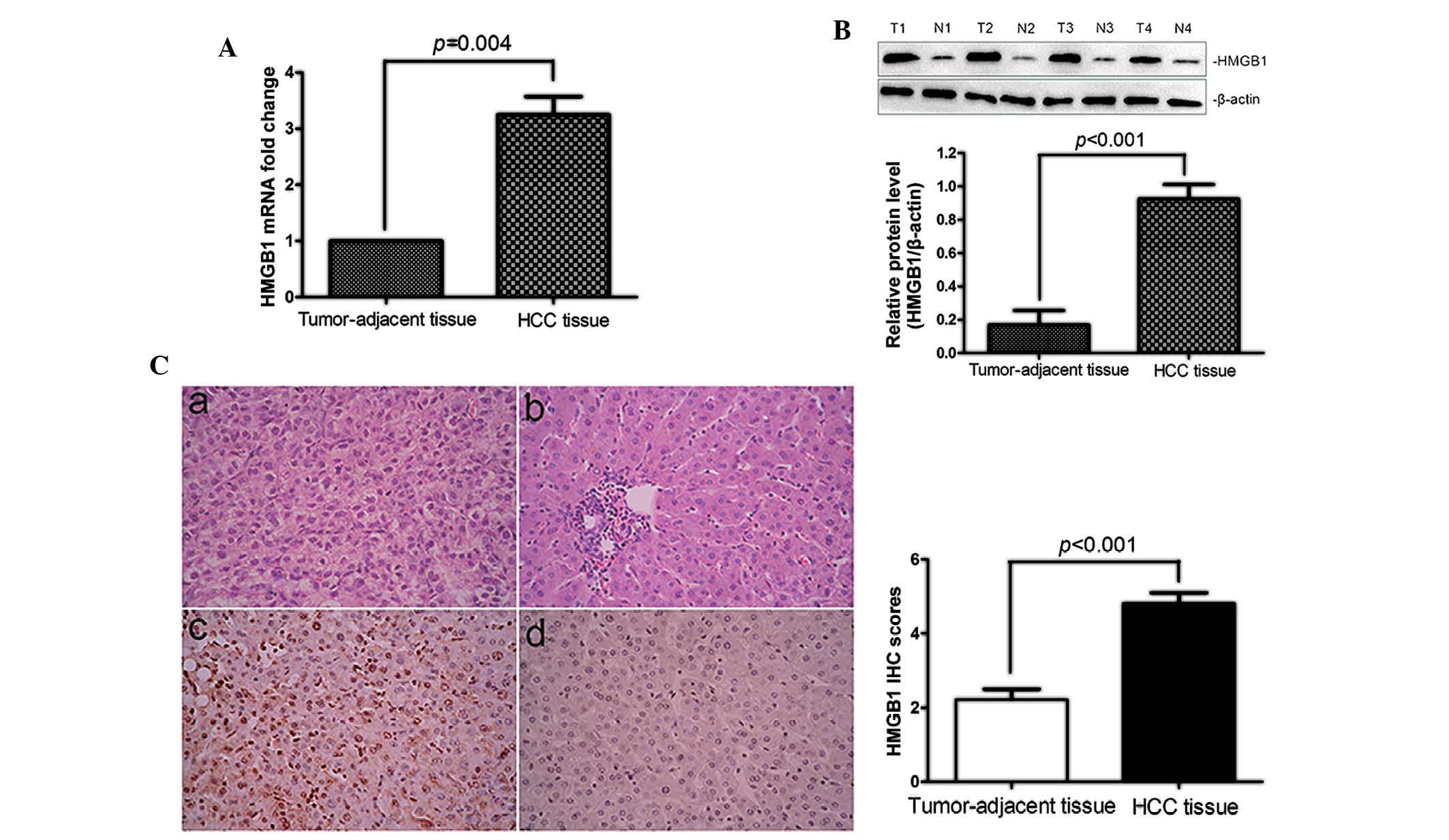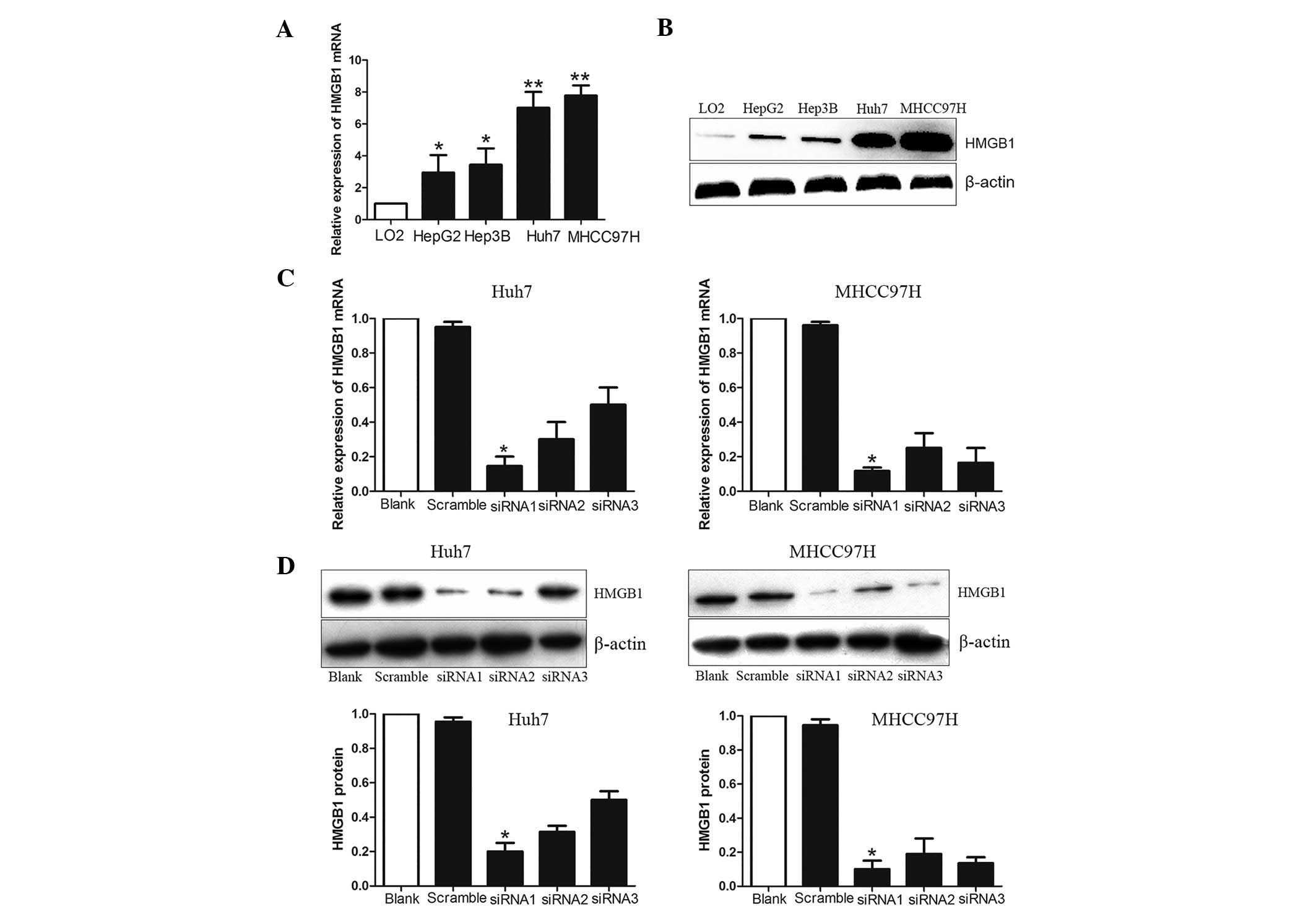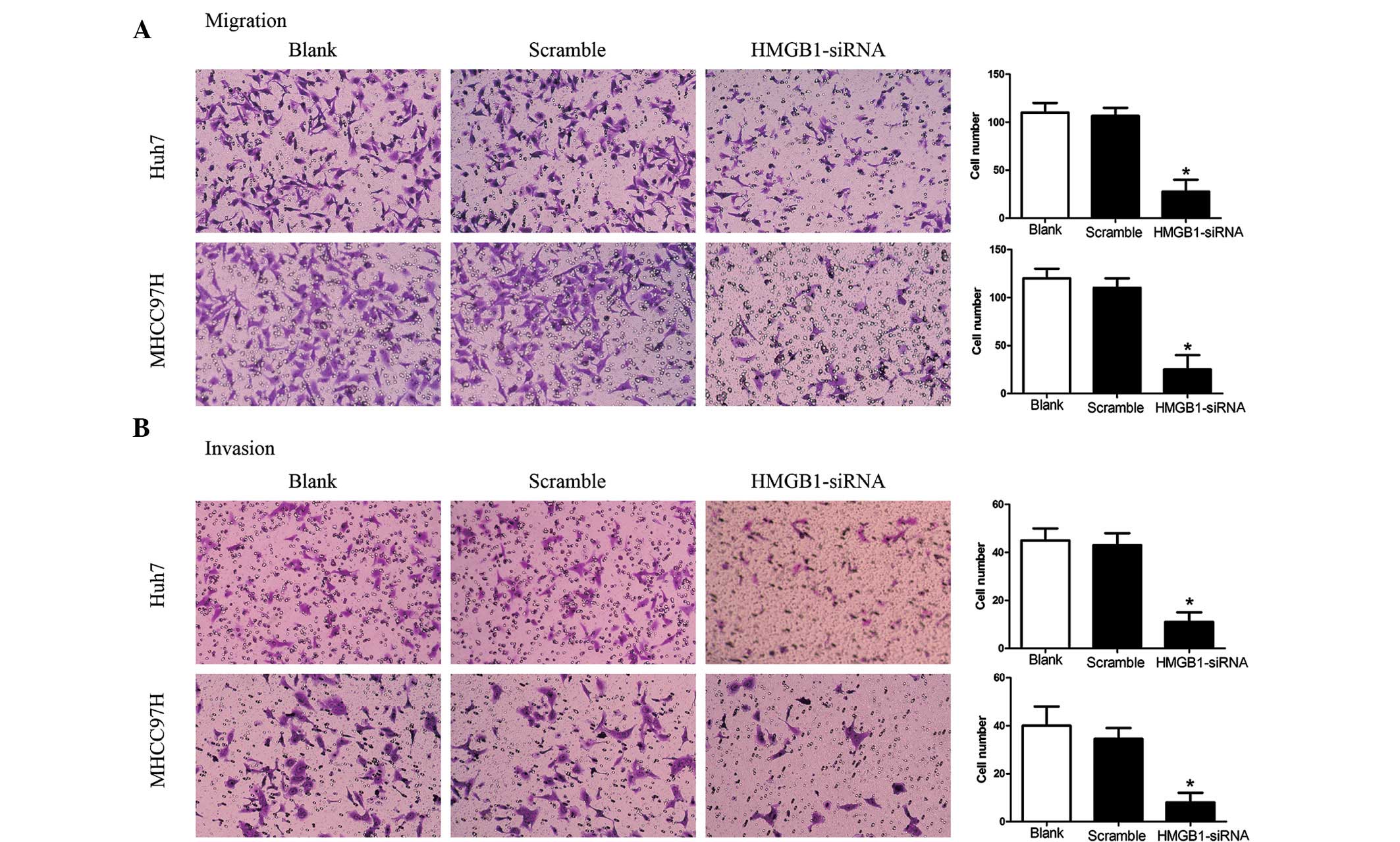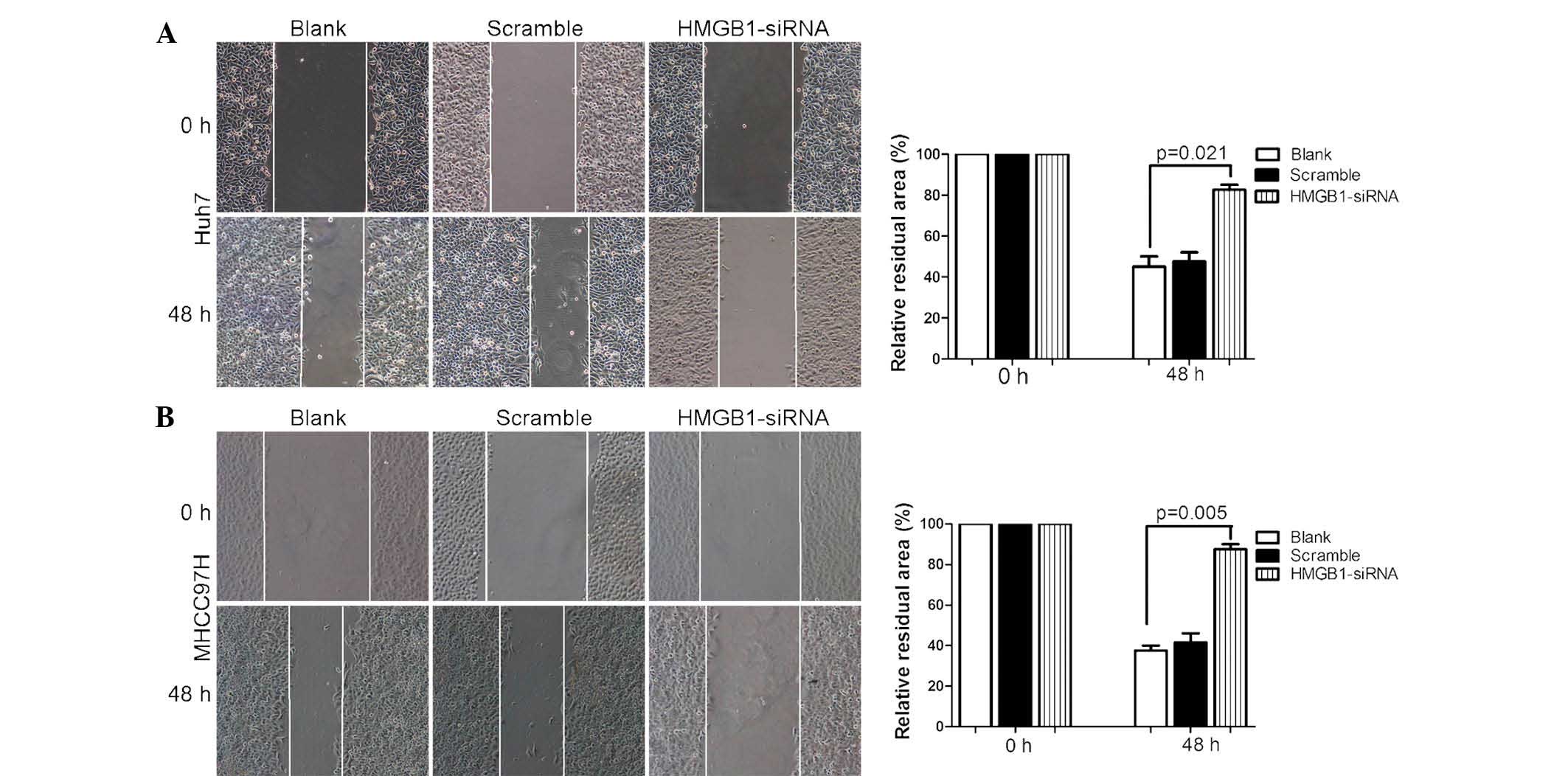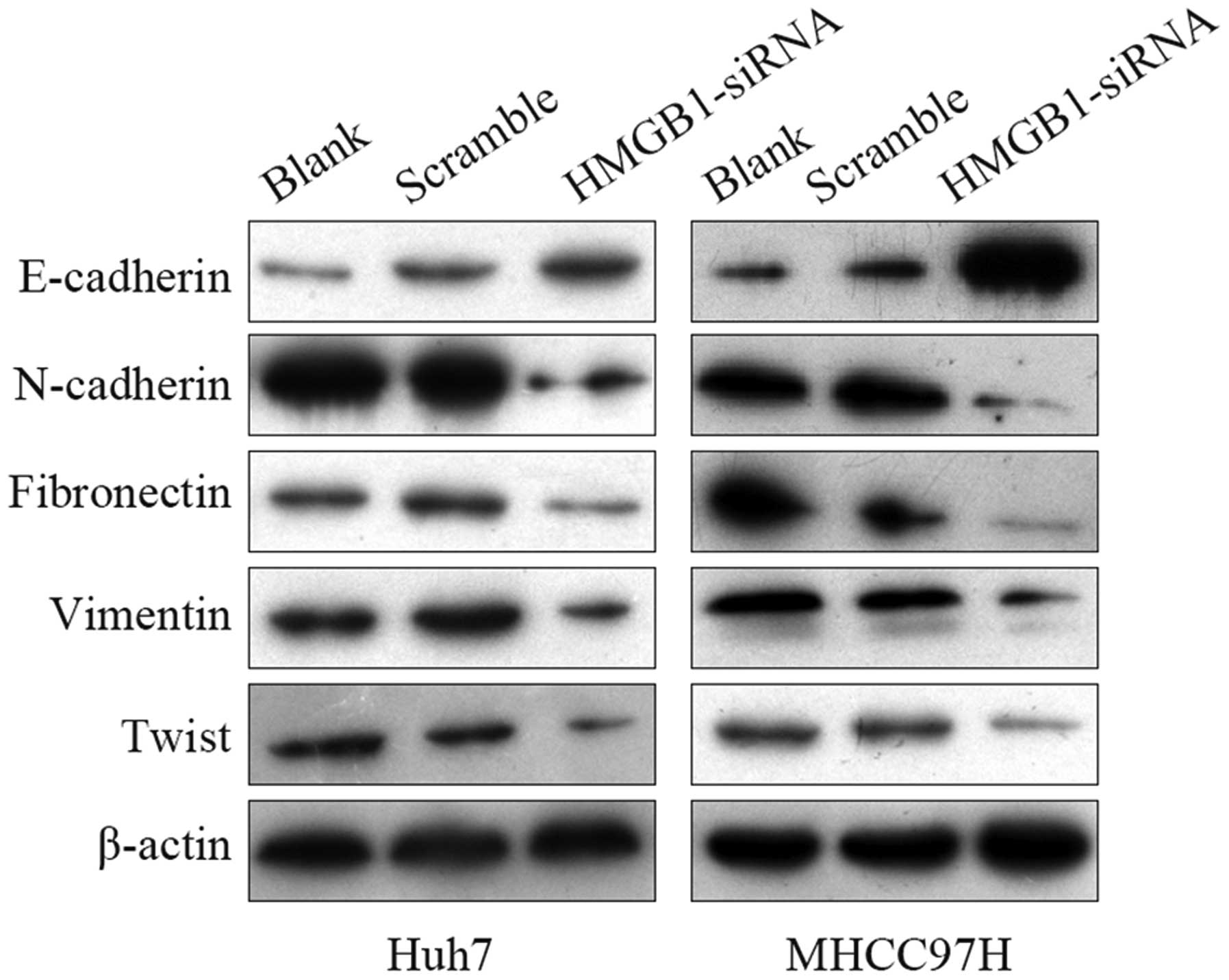High‑mobility group box 1 has a prognostic role and contributes to epithelial mesenchymal transition in human hepatocellular carcinoma
- Authors:
- Published online on: August 5, 2015 https://doi.org/10.3892/mmr.2015.4182
- Pages: 5997-6004
Abstract
Introduction
Hepatocellular carcinoma (HCC) is the fifth most common type of cancer worldwide, with ~750,000 newly diagnosed patients each year (1). Most HCCs develop from either a viral hepatitis infection (hepatitis B or C) or cirrhosis (2). Clinical treatment of HCC has remained challenging due to of a lack of effective chemotherapy and clearly defined end-points for clinical protocols (3,4). The poor outcome of HCC patients has largely been attributed to intrahepatic or distant metastasis. The underlying mechanisms responsible for metastatic spread of HCC have remained to be fully elucidated. Therefore, it is important to explore the underlying mechanisms of HCC metastasis and develop more effective treatments. RNA interference (RNAi) is a powerful post-transcriptional gene-silencing mechanism in which homologous RNA sequences are transfected into the cells by use of synthetic small interfering RNA (siRNAs), or plasmid or viral vectors encoding for short hairpin RNAs, inhibiting the expression of a particular gene (5,6). RNAi-based approaches have recently entered clinical trials (7). Hence, RNAi has been regarded as a novel promising therapy for HCC.
High-mobility group box 1 (HMGB1), a member of the high-mobility group protein family, was originally characterized as a non-histone, nuclear DNA-binding protein (8,9). It has been implicated in several disease states, including sepsis, arthritis, ischemia-re-perfusion injury and cancer (10,11). It also functions as an extracellular signaling molecule during inflammation, cell differentiation, cell migration and tumor metastasis (12). Previous studies have also reported that HMGB1 signaling proceeds via Toll-like receptors (TLRs), including TLR-2 and TLR-4, and the receptor for advanced glycation end-products (RAGE) to induce the nuclear translocation of nuclear factor κB, resulting in an enhanced production of pro-inflammatory cytokines, including tumor necrosis factor α and interleukin 1b (13–15). Blockade of the RAGE-HMGB1 interaction was shown to suppress tumor growth and metastasis (16). In addition, constant release of HMGB1 as a pro-inflammatory cytokine from necrotic tumor cells can create a microenvironment similar to that of chronic inflammation, a condition known to contribute to the development of epithelial malignancies (17). Epithelial mesenchymal transition (EMT) was shown to promote the migratory and invasive capacity of HCC cells (18). EMT is a critical, highly conserved process which controls cell differentiation and embryonic development. Emerging evidence revealed that EMT endows cancer cells with various malignant characteristics, including increased mobility, invasiveness, evasion of apoptosis and stem-like phenotypes (19). However, the association between HMGB1 and EMT has remained elusive. Therefore, the present study investigated whether inhibiting HMGB1 may attenuate EMT and thus block the metastasis and invasion of HCC cells.
The present study evaluated HCC specimens with regard to HMGB1 expression, and performed correlation analyses of HMGB1 with clinicopathological parameters and survival rates in order to determine the potential value of HMGB1 as an independent prognostic factor in HCC. Furthermore, in vitro experiments employing specific siRNAs targeting HMGB1 (HMGB1-siRNAs) were performed in order to investigate the role of HMGB1 in cell invasion and metastasis.
Materials and methods
Ethical review
All protocols were approved by the Xi'an Jiaotong University Ethics Committee (Xi'an, China) according to the 1975 Declaration of Helsinki. Written informed consent was obtained from each patient.
Clinical samples and cell lines
A total of 68 HCC patients, including 51 males and 17 females (range, 31–75 years; median, 54 years) who underwent curative liver resection at the Department of Hepatobiliary Surgery, First Affiliated Hospital of Medical College of Xi'an Jiaotong University (Xi'an, China) from January 2010 to December 2010 were included in the present study. Patients had a median follow-up time of 22.5 months. None of the patients received any chemotherapy, radiotherapy or radiofrequency ablation prior to surgery. HCC tissues and matched normal tumor-adjacent tissues (>2 cm distance of the surgical margin) were collected and immediately stored in 4% paraformaldehyde solution for immunohistochemistry (IHC) or in liquid nitrogen for western blot analysis. Data regarding the demographic and clinicopathological characteristics were obtained from the medical records of the patients. The human immortalized liver cell line LO2 and four HCC cell lines, HepG2, Hep3B, Huh7 and MHCC97H, were obtained from the Institute of Biochemistry and Cell Biology, Chinese Academy of Sciences (Shanghai, China). Cells were cultured in complete Dulbecco's modified Eagle medium (DMEM; Mediatech, Manassas, VA, USA) containing 10% fetal bovine serum (FBS; Gibco-BRL, Invitrogen Life Technologies, Carlsbad, CA, USA) in a humidified 5% CO2 incubator at 37°C. Cells in the logarithmic growth phase were used in the in vitro assays.
IHC analysis
IHC was performed on paraformaldehyde-fixed paraffin sections. Samples were subjected to immunostaining with HMGB1 polyclonal antibody (cat. no. 3935; dilution, 1:100) obtained from Cell Signaling Technology, Inc., (Danvers, MA, USA) followed by streptavidin peroxidase-conjugated secondary antibody (1:2,000; cat. no. pv-9001; Zhongshan Goldenbridge Biotechnology Co., Ltd., Beijing, China). The staining for the HMGB1 protein was semi-quantitatively evaluated by multiplying the staining intensity with the percentage of positive liver cells. The staining intensity was expressed as four grades: 0, None; 1, weak; 2, moderate; and 3, strong. The percentage of HMGB1-positive liver cells was expressed using the following grades: 0, <5%; 1, 6–25%; 2, 26–50%; 3, 51–75%; and 4, >75%. Ten independent high-magnification felds (x400) were evaluated for each section using a laser scanning confocal microscope (TCS2 SP5; Leica Microsystems, Wetzlar, G ermany), and the average scores of ten fields represented the final results. Sections with a total score of >1 were defined as exhibiting positive staining for the HMGB1 protein.
siRNA transfection
The specific siRNA against HMGB1 (pre-designed siRNA; Table I) and scramble siRNA were synthesized by GenePharma Co., Ltd. (Shanghai, China). Huh7 cells were seeded in six-well plates at the concentration of 2×105/well and divided into two groups: The HMGB1 siRNA group and the control siRNA group. Huh7 or MHCC97H cells were transfected with 150 pmol siRNA (HMGB1 siRNA or control siRNA) using 5 µl Lipofectamine 2000 (Invitrogen Life Technologies) according to the manufacturer's instructions, and cultured in a humidified 5% CO2 incubator at 37°C. Serum-free medium was changed to complete medium 6 h after transfection. Cells were harvested 48 h after transfection and used for further experiments.
Reverse transcription quantitative polymerase chain reaction (RT-qPCR)
Total RNA was isolated from HCC tissues and HCC cells using TRIzol reagent (Invitrogen Life Technologies) according to the manufacturer's instructions. The first-strand cDNA was synthesized using the Revertid™ First Strand cDNA Synthesis kit (Fermentas, Burlington, ON, Canada). cDNA (2 µl) obtained from each sample was amplified and quantified by real-time PCR using SYBR® Premix Ex TaqTM II (Tli RNaseH Plus; Takara Bio Inc., Shiga, Japan). PCR amplification was conducted using an ABI Prism 7300 Sequence Detection system (Applied Biosystems Life Technologies, Foster City, CA, USA) under the following conditions: 94°C for 3 min, followed by 35 cycles of 94°C for 30 sec and 60°C for 30 sec. The human β-actin gene served as an internal control gene to ensure that an equal amount of mRNA was analyzed from each sample. The primers were synthesized by GenePharma Co., Ltd. (Shanghai, China) and the sequences are shown in Table I. Relative gene expression was calculated as 2−ΔCt[ΔCt=Ct(target gene) - Ct(β -actin). Three independent experimental replicates were performed.
Western blot analysis
Western blotting was conducted as described in our previous study (20). HMGB1 (cat. no. SC-393423; 1:1,000) and β-actin (cat. no. SC-130301; Santa Cruz Biotechnology, Inc., Dallas, TX, USA; dilution, 1:5,000) antibodies were incubated at 4°C overnight for western blot analysis. Secondary horseradish peroxidase-conjugated goat anti-mouse antibody (Bio-Rad Laboratories, Inc., Hercules, CA, USA) were used at a 1:5,000 dilution at room temperature for 1 h, visualized using an Enhanced Chemiluminescence Reagent (Millipore, Billerica, MA, USA) and analyzed using Quantity One 1-D analysis software (Bio-Rad Laboratories, Inc.).
Wound healing assay
The confluent cells were seeded in six-well plates and allowed to form cell monolayers overnight. A sterile 200-µl plastic pipette tip was used to create a line-shaped wound across the cell monolayer, and the detached cells were removed by rinsing with phosphate-buffered saline (PBS). Cells were cultured in serum-free DMEM in a humidified 5% CO2 incubator at 37°C for 48 h, and images were captured with a phase-contrast microscope (COIC4365; Nikon, Tokyo, Japan).
Transwell assay
The 8-µM pore-size Transwell inserts (Nalge Nunc, Penfield, NY, USA) were coated with Matrigel (BD Biosciences, Franklin Lakes, NJ, USA) at 1 mg/ml on the inner layer. Huh7 cells were transfected with siRNA for 48 h and then seeded at 2.5×105 cells/ml in 200 µl into the upper chambers of the Transwell inserts. 750 µl DMEM containing 10% FBS was added to the lower chambers, and the Transwell plates were incubated for 24 h Cells were fixed in 4% paraformaldehyde for 2 min and then permeabilized with methanol for 20 min at room temperature. The cells on the inner layer were gently removed with a cotton swab and the adherent cells on the lower surface of the insert were stained with 0.3% crystal violet dye (Bio-Rad, Inc.) for 15 min. The filters were washed with PBS and images were captured. Invaded cells on the lower surface were counted under a light microscope.
Statistical analysis
Values are expressed as the mean ± standard deviation. The SPSS statistical package for Windows version 13 (SPSS, Chicago, IL, USA) was used for Pearson's χ2 test and the multivariate Cox regression analysis. Two-tailed Student's t-test, Kaplan-Meier plots, log-rank test or analysis of variance were used to evaluate statistical significance using GraphPad Prism 5 software (GraphPad Software, Inc., La Jolla, CA, USA). P<0.05 was considered to indicate a statistically significant difference and all experiments were repeated independently, three times.
Results
Clinical significance of elevated HMGB1 expression in HCC tissues
The expression of HMGB1 in HCC tissues and normal adjacent tissues was at the mRNA and protein level by RT-qPCR, IHC and western blot analysis. As shown in Fig. 1A and B, HMGB1 mRNA and protein expression was significantly upregulated in HCC tissues compared with that in their matched normal tumor-adjacent tissues (P=0.004 and P<0.001, respectively). IHC analysis revealed the presence of HMGB1 in the cytoplasm and nuclei of HCC cells in the tissue samples. The IHC results were further confirmed by western blot analysis (P<0.001; Fig. 1C). Clinical association analysis by the Pearson χ2 test revealed that elevated HMGB1 expression in HCC tissues was significantly associated with large tumor size (≥5 cm; P=0.001), high histological grade (Edmondson-Steiner grades III and IV; P=0.001) and advanced tumor stage [tumor-node-metastasis (TNM) stages III and IV; P=0.003) (Table II). These results demonstrated elevated expression of HMGB1 in HCC and its correlation with poor clinicopathological features in HCC.
Positive expression of HMGB1 correlates with a decreased three-year survival of HCC patients
The present study next investigated whether HMGB1 was a prognostic factor for HCC patients. The overall survival (OS) and disease-free survival (DFS) time of the 68 cases were determined at the three-year follow-up, correlated with positive and negative HMGB1 expression and depicted in Kaplan-Meier survival curves. A significant correlation was detected between positive expression of HMGB1 and shorter OS and DFS (P=0.004 and P=0.002, respectively; Fig. 2). The OS and DFS median survival time in the HMGB1-positive expression group was shorter than that in the HMGB1-negative expression group (12 vs. 24 months and 9 vs. 21 months, respectively). Multivariate analysis of all of the significant clinical factors for OS and DFS indicated that HMGB1-positive expression (P=0.021 and P=0.034, respectively; Table III) was an independent prognostic factor for HCC patients. Thus, HMGB1 may be a potential biomarker for predicting the clinical outcomes of HCC.
Table IIIMultivariate Cox regression analysis of three-year overall survival and disease-free survival of 68 hepatocellular carcinoma patients. |
RNAi with HMGB1 expression in HCC cells
To explore the effects of HMGB1 on the invasiveness of HCC cells, the expression of HMGB1 was assessed in a panel of HCC cell lines, which are known to exhibit an elevated invasive behavior. The mRNA and protein expression levels of HMGB1 increased progressively from healthy liver cells to HCC cells with low metastatic potential and, finally, to HCC cells with high metastatic potential (Fig. 3A and B). To further examine the effect of HMGB1 on the motility and invasiveness, the knockdown effect of siRNA was first minimized by using three specific HMGB1-siRNAs. siRNAs1-3 or scramble siRNA were transfected into Huh7 and MHCC97H cells, which exhibited the highest expression of HMGB1 among the cell lines tested, using Lipofectamine 2000. HMGB1 expression was evaluated by RT-qPCR and western blot analyses. The results indicated that all of the HMGB1-siRNAs significantly inhibited the mRNA and protein expression of HMGB1 in Huh7 and MHCC97H cells (Fig. 3C–E). Inhibition was highest (80–90%) for HMGB1-siRNA-1, which was therefore selected to be used in the subsequent knockdown experiments.
HMGB1-siRNA-1 inhibits the migration and invasion of Huh7 and MHCC97H cells
As show in Fig. 4, knockdown of HMGB1 in the highly invasive Huh7 and MHCC97H cells decreased their migratory and invasive behaviors (Fig. 4A and B). A Transwell assay revealed that the migration and invasion of cells in the HMGB-siRNA-transfected group was inhibited compared with that in the control groups (Huh7, P<0.01; MHCC97H, P<0.001). Cell motility was also examined using a wound healing assay (Fig. 5). The results showed that HMGB1 knockdown significantly inhibited HCC cell migration and invasion.
HMGB1 induces EM T in HCC cells
EMT has an impor tant role in metastasis, as it induces tumor-associated epithelial cells to obtain mesenchymal features, which leads to reduced cell-cell contact and increased migratory ability (16). Thus, the present study next investigated how HMGB1 regulates the migratory and invasive phenotypes of HCC cells. The expression of EMT markers was evaluated by western blot analysis (Fig. 6). The results showed that knockdown of HMGB1 in Huh7 and MHCC97H cells led to a marked increase in the expression of epithelial marker E-cadherin and marked decreases in the expression of mesenchymal markers N-cadherin, fibronectin, vimentin and twist. These findings suggested that HMGB1 induced EMT in HCC cells.
Discussion
HCC is one of the leading causes of cancer-associated mortality worldwide (17). Surgical treatment, including hepatic resection and liver transplantation at the early stage, is the only curative therapy for HCC patients. Unfortunately, due to the high frequency of intrahepatic and extrahepatic metastasis, most HCC patients are diagnosed at the advanced stage and are not eligible for hepatic resection, which leads to a poor prognosis for HCC. Hence, it is urgently required to explore the molecular mechanism of HCC progression and discover novel HCC markers and targeting agents.
The present study demonstrated that HMGB1 was signifcantly upregulated in HCC tissues compared with that in tumor-adjacent tissues. Furthermore, elevated HMGB1 expression was significantly associated with large tumor size (>5 cm), high Edmonson-Steiner classification (stages III and IV) and advanced TNM stage (III and IV). Kaplan-Meier analysis revealed that HMGB1 expression was correlated with a poorer survival of HCC patients after hepatectomy. Furthermore, multivariate Cox regression analysis showed that HMGB1 was an independent factor for predicting the three-year overall and disease-free survival in HCC patients. These results showed that the status of HMGB1 was critical for the prognosis of HCC patients.
Furthermore, the present study determined the functional signifcance of HMGB1 overexpression in HCC cell lines. The HMGB1 content was low in normal hepatocytes, increased in non-invasive and primary HCC cells, and was highest in invasive HCC cell lines. The expression of HMGB1 was in parallel with the invasiveness and motility of the respective cell lines, indicating that HMGB1 may be used as a potential marker for HCC. The in vitro experiments demonstrated, for the first time, to the best of our knowledge, that HMGB1 knockdown by a specifc siRNA inhibited cell migration and invasion of Huh7 and MHCC97H cells. As migration and invasion represent the cytological basis of tumor metastasis and the specifc inhibition of HMGB1 expression reduced HCC migration and invasion in vitro, HMGB1 may be utilized as a therapeutic target.
Metastasis is regarded as the main cause of mortality in cancer patients (21). For patients with HCC, the poor prognosis is mainly attributed to intrahepatic and distant metastasis. The metastatic process includes a series of interdependent events, including cancer cell proliferation, migration and invasion (22). As a nuclear protein, HMGB1 has dual roles as a chromatin structural protein and a cytokine (23). It is involved in a variety of processes of cancer progression, including cell proliferation, angiogenesis, invasion and metastasis (11,24). The present study demonstrated that knockdown of HMGB1 inhibited the migration and invasion of Huh7 and MHCC97H cells, which was in agreement with previous studies on other malignancies (11,25), indicating that HMGB1 is involved in tumor metastasis.
In the present study, wester n blot a nalysis of EMT-associate d proteins showed that the EMT was reduced after knockdown of HMGB1. This indicated that HMGB1 mediated metastasis of HCC through regulating the EMT. Therefore, HMGB1 may be an ideal therapeutic target for metastatic HCC.
In conclusion, the results of the present study revealed that RNAi-mediated knockdown of HMGB1 effectively inhibited the migration and invasion of Huh7 and MHCC97H cells. The expression of EMT markers was inhibited by HMGB1-siRNA-1, indicating that HMGB1 is involved in the development of metastasis. Therefore, HMGB1 may serve as a potential target for the treatment of metastatic HCC. Furthermore, HMGB1 was demonstrated to be an independent prognostic factor for HCC. Further study is required to clarify the mechanisms by which HMGB1 is involved in the initiation and progression of HCC as well as the formation of metastasis via stimulating EMT.
Acknowledgments
This study was supported by grants from the National Natural Scientifc Foundation of China (nos. 81272645 and 81072052 to Qingguang Liu), Key Science and Technology Fund of Shaanxi Province (no. 2010K01-131 to Tao Song) and the Funds for Creative Research sponsored by The First Affliated Hospital of Xi'an Jiaotong University (14YB10 to Zhikui Liu).
References
|
El-Serag HB and Rudolph KL: Hepatocellular carcinoma: Epidemiology and molecular carcinogenesis. Gastroenterology. 132:2557–2576. 2007. View Article : Google Scholar : PubMed/NCBI | |
|
Smith MW, Yue ZN, Korth MJ, Do HA, Boix L, Fausto N, Bruix J, Carithers RL Jr and Katze MG: Hepatitis C virus and liver disease: Global transcriptional profling and identifcation of potential markers. Hepatology. 38:1458–1467. 2003. View Article : Google Scholar : PubMed/NCBI | |
|
Llovet JM, Di Bisceglie AM, Bruix J, Kramer BS, Lencioni R, Zhu AX, Sherman M, Schwartz M, Lotze M, Talwalkar J, et al: Design and endpoints of clinical trials in hepatocellular carcinoma. J Natl Cancer Inst. 100:698–711. 2008. View Article : Google Scholar : PubMed/NCBI | |
|
Talwalkar JA and Gores GJ: Diagnosis and staging of hepatocellular carcinoma. Gastroenterology. 127(5 Suppl 1): S126–S132. 2004. View Article : Google Scholar : PubMed/NCBI | |
|
Kim DH and Rossi JJ: Strategies for silencing human disease using RNA interference. Nat Rev Genet. 8:173–184. 2007. View Article : Google Scholar : PubMed/NCBI | |
|
Gartel AL and Kandel ES: RNA interference in cancer. Biomol Eng. 23:17–34. 2006. View Article : Google Scholar : PubMed/NCBI | |
|
Castanotto D and Rossi JJ: The promises and pitfalls of RNA-interference-based therapeutics. Nature. 457:426–433. 2009. View Article : Google Scholar : PubMed/NCBI | |
|
Javaherian K, Liu JF and Wang JC: Nonhistone proteins HMG1 and HMG2 change the DNA helical structure. Science. 199:1345–1346. 1978. View Article : Google Scholar : PubMed/NCBI | |
|
Lotze MT and Tracey KJ: High-mobility group box 1 protein (HMGB1): Nuclear weapon in the immune arsenal. Nat Rev Immunol. 5:331–42. 2005. View Article : Google Scholar : PubMed/NCBI | |
|
Sims GP, Rowe DC, Rietdijk ST, Herbst R and Coyle AJ: HMGB1 and RAGE in infammation and cancer. Annu Rev Immunol. 28:367–88. 2010. View Article : Google Scholar | |
|
Tang D, Kang R, Zeh HJ III and Lotze MT: High-mobility group box 1 and cancer. Biochim Biophys Acta. 1799:131–40. 2010. View Article : Google Scholar : PubMed/NCBI | |
|
Kostova N, Zlateva S, Ugrinova I and Pasheva E: The expression of HMGB1 protein and its receptor RAGE in human malignant tumors. Mol Cell Biochem. 337:251–58. 2010. View Article : Google Scholar | |
|
Park JS, Gamboni-Robertson F, He Q, Svetkauskaite D, Kim JY, Strassheim D, Sohn JW, Yamada S, Maruyama I, Banerjee A, et al: High mobility group box 1 protein interacts with multiple Toll-like receptors. Am J Physiol Cell Physiol. 290:C917–924. 2006. View Article : Google Scholar | |
|
Yu M, Wang H, Ding A, Golenbock DT, Latz E, Czura CJ, Fenton MJ, Tracey KJ and Yang H: HMGB1 signals through toll-like receptor (TLR) 4 and TLR2. Shock. 26:174–79. 2006. View Article : Google Scholar : PubMed/NCBI | |
|
Wolfson RK, Chiang ET and Garcia JG: HMGB1 induces human lung endothelial cell cytoskeletal rearrangement and barrier disruption. Microvasc Res. 81:189–97. 2011. View Article : Google Scholar | |
|
Larocca C, Cohen JR, Fernando RI, Huang B, Hamilton DH and Palena C: An autocrine loop between TGF-β1 and the transcription factor brachyury controls the transition of human carcinoma cells into a mesenchymal phenotype. Mol Cancer Ther. 12:1805–815. 2013. View Article : Google Scholar : PubMed/NCBI | |
|
Yang JD, Harmsen WS, Slettedahl SW, Chaiteerakij R, Enders FT, Therneau TM, Orsini L, Kim WR and Roberts LR: Factors that affect risk for hepatocellular carcinoma and effects of surveillance. Clin Gastroenterol Hepatol. 9:617–623.e1. 2011. View Article : Google Scholar : PubMed/NCBI | |
|
El-Nahas AM: Plasticity of kidney cells: Role in kidney remodeling and scarring. Kidney Int. 64:1553–563. 2003. View Article : Google Scholar : PubMed/NCBI | |
|
Sato M, Shames DS and Hasegawa Y: Emerging evidence of epithelial-to-mesenchymal transition in lung carcinogenesis. Respirology. 17:1048–059. 2012. View Article : Google Scholar : PubMed/NCBI | |
|
Liu Z, Dou C, Jia Y, Li Q, Zheng X, Yai Y, Liu Q and Song T: RIG-I suppresses the migration and invasion of hepatocellular carcinoma cells by regulating MMP9. Int J Oncol. 46:1710–720. 2015.PubMed/NCBI | |
|
Rudmik LR and Magliocco AM: Molecular mechanisms of hepatic metastasis in colorectal cancer. J Surg Oncol. 92:347–59. 2005. View Article : Google Scholar : PubMed/NCBI | |
|
Kumar S and Weaver VM: Mechanics, malignancy and metastasis: The force journey of a tumor cell. Cancer Metastasis Rev. 28:113–27. 2009. View Article : Google Scholar : PubMed/NCBI | |
|
Naghavi MH, Nowak P, Andersson J, Sönnerborg A, Yang H, Tracey KJ and Vahlne A: Intracellular high mobility group B1 protein (HMGB1) represses HIV-1 LTR-directed transcription in a promoter-and cell-specifc manner. Virology. 314:179–189. 2003. View Article : Google Scholar : PubMed/NCBI | |
|
Ueda M, Takahashi Y, Shinden Y, Sakimura S, Hirata H, Uchi R, Takano Y, Kurashige J, Iguchi T, Eguchi H, et al: Prognostic signifcance of high mobility group box 1 (HMGB1) expression in patients with colorectal cancer. Anticancer Res. 34:5357–5362. 2014.PubMed/NCBI | |
|
Li LC, Gao J and Li J: Emerging role of HMGB1 in fbrotic diseases. J Cell Mol Med. 18:2331–2339. 2014. View Article : Google Scholar : PubMed/NCBI |



